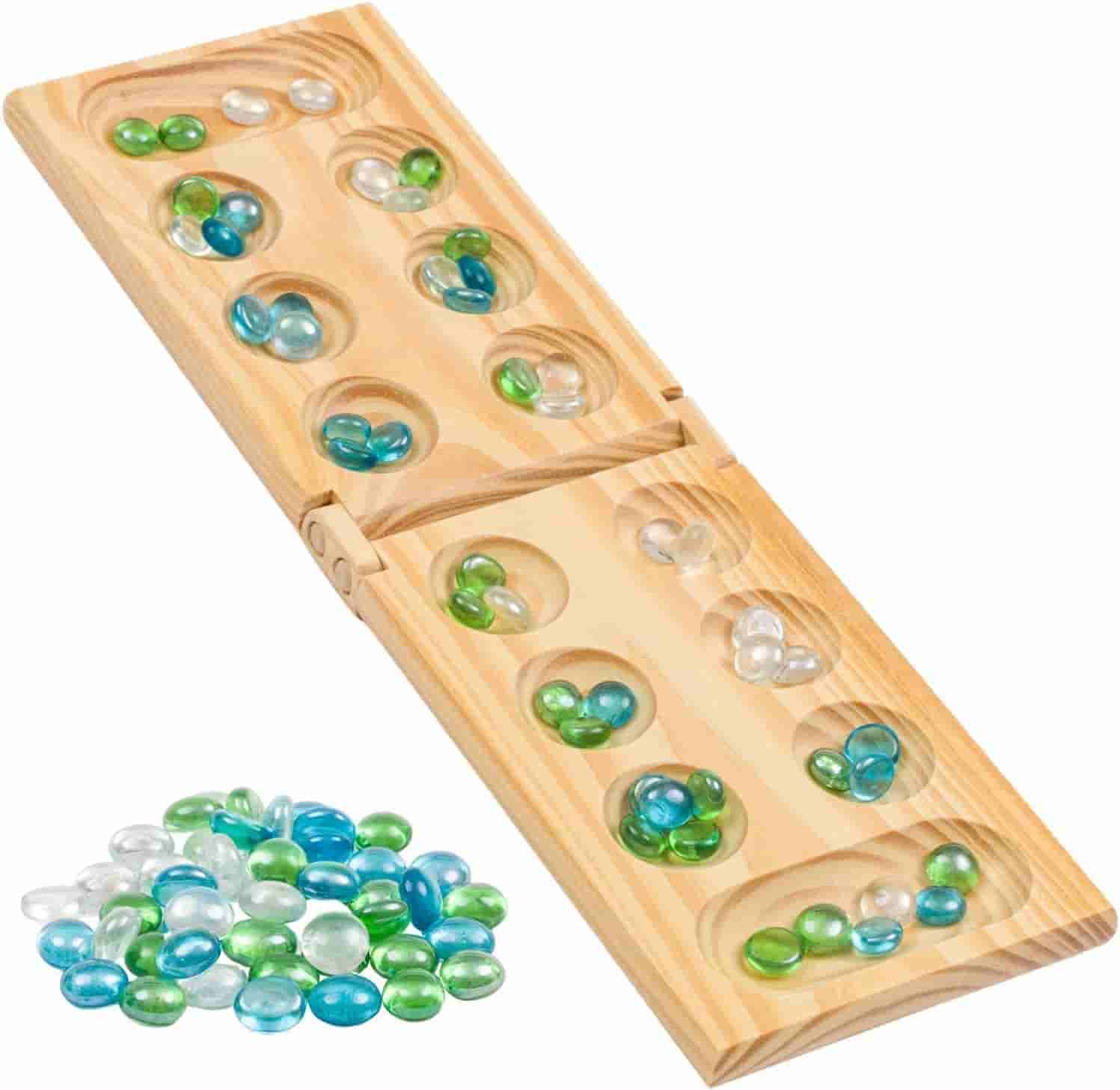Mancala is a series of turn-based strategy board games for two players that are played on a board, other playing surface, or with small stones, beans, or seeds and rows of holes or pits in the ground. Usually, the goal is to take all of the opponent’s pieces, or a certain set of them.
The game has a long history, with evidence of its existence dating back to ancient civilizations such as Ancient Egypt and the Middle East. It is known by various names across different regions and cultures, including “Bao” in East Africa and “Kalah” in the Western world.
How do you set up a Mancala Game?
To set up a Mancala game, follow these steps:
- Place the game board between the two players lengthwise. The board has two rows of six small holes called “pockets” and two larger holes called “mancalas” or “stores” on opposite ends.
- Each player has six pockets directly in front of them and a mancala to their right.
- Place four stones or seeds in each of the 12 pockets. The color of the stones does not matter.
- The stores remain empty at the start of the game.
- Decide who goes first, either by a coin flip or other method.
So in summary, set up the board with 4 stones in each of the 12 pockets, leaving the two stores empty, and determine who will make the first move. The objective is to capture the most stones in your mancala by the end of the game.

What are the Basic Rules of Mancala?
The basic rules of Mancala are as follows:
Setup:
Place four seeds in each of the six pockets on your side of the game board. Your opponent should do the same. The colors of the seeds do not matter.
Objective:
The objective is to collect as many seeds in your store as possible. The player with the most seeds in their store at the end of the game wins,
Gameplay:
Basic Rules:
- Play moves in a counter-clockwise circle (to the right).
- The store on your right belongs to you, where you keep the seeds you win.
- The six pits near you are your pits.
- When picking up and placing seeds, use only one hand.
- Once you touch the seeds in a pit, you must move those seeds.
- Put seeds only in your own store—never in the store of your rival.
Starting the Game:
On a turn, a player picks up all the seeds in one pit and “sows” them to the right, placing one seed in each of the pits along the way. If you visit your store, proceed by adding a seed and going forward. Along the way, you might find yourself planting seeds in your opponent’s trenches.
Special Rules:
- Free Turn: If the last seed in your hand lands in your store, you take another turn.
- Capturing: If the last seed in your hand lands in one of your own pits, and that pit was empty, you capture all the seeds in your opponent’s pit on the opposite side. Put those captured seeds, as well as the last seed you just played, into your store.
Ending the Game:
The game ends when one player’s pits are completely empty. The other player takes the seeds remaining in their pits and puts them in their store. Count up the seeds. Whoever has the most seeds wins.
These basic rules provide the foundation for playing this game effectively.
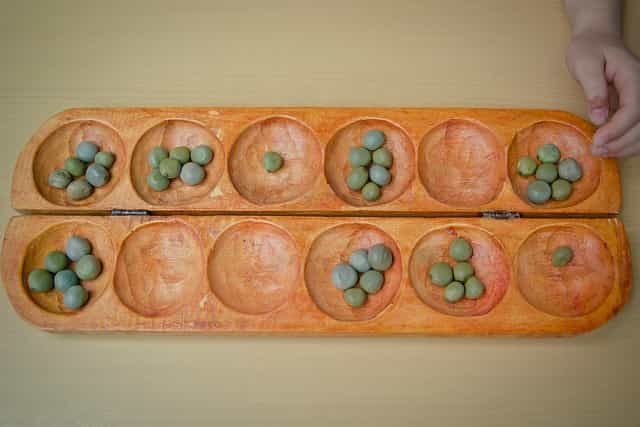
How to Play Mancala?
To play the game, follow these steps:
Setup
Game Board:
Place the game board between the two players lengthwise. The board features two rows of six small holes called “pockets” and two larger holes called “stores” on opposite ends.
Seeds:
Each player has six pockets directly in front of them and a store to their right. Place four seeds in each of the 12 pockets. It is unimportant what color the seeds are.
Gameplay
Choosing Who Goes First:
Determine who goes first using a house rule, such as flipping a coin or letting the youngest player go first.
Starting the Game:
One of the six pockets is selected by the player who goes first.They remove all the stones from that pocket and drop them, one by one, in each of the next pockets, moving in a counter-clockwise direction around the board until they’re out of stones.
Dropping Seeds:
If the player passes their own store, they will drop a stone in it. If they have stones after passing their store, they continue to drop them into the other player’s pockets. If they pass the other player’s store, they do not put a stone in their store.
Capturing:
If the last seed in your hand lands in one of your own pits, and that pit was empty, you capture all the seeds in your opponent’s pit on the opposite side. Put those captured seeds, as well as the last seed you just played, into your store.
Free Turn:
If the last seed in your hand lands in your store, you take another turn.
Ending the Game:
When one player has completely depleted their pockets, the game is over. The other player takes the remaining seeds in their pockets and puts them in their store. Count up the seeds. The winner is the player whose store has the most seeds.
Strategies
Getting a Free Turn:
One of the easiest strategies is to get a free turn by placing your last seed in your store.
Gathering More Stones:
Strategically drop your last seed into an empty hole on your side of the board to gather more stones.
Thinking Strategically:
To increase your chances of winning, thoroughly consider your next move.
Winning the Game:
When one player has completely depleted their pockets, the game is over. The winner is the player whose store has the most seeds.
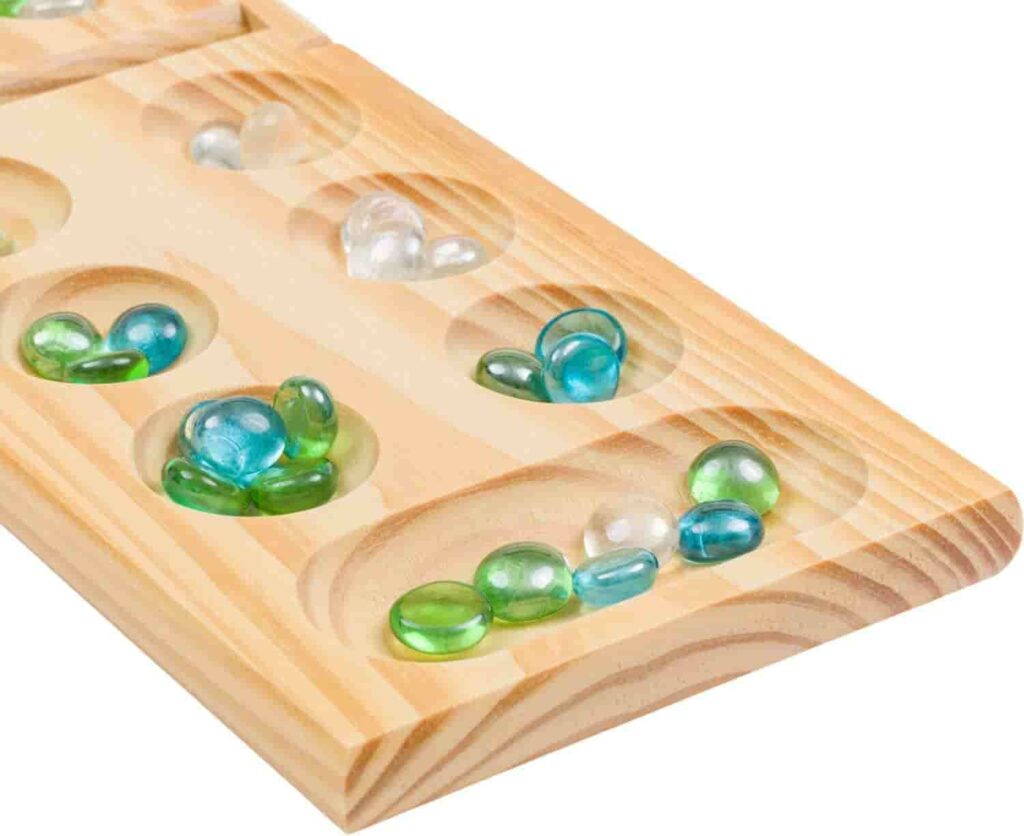
How to Win Mancala?
To win at this game, follow these strategies:
Playing the Opening Moves Strategically
Go First:
Going first gives you an advantage. Move your first stone from the third hole to land in your store, which allows you to score a point and take another turn.
Block Opponent’s Moves:
Play a stone from the rightmost or second-rightmost hole to block your opponent from making the same opening move.
Stay Focused on Reaching Your Mancala
Make Moves to Get a Free Turn:
Ensure your last stone lands in your mancala to get a free turn.
Prevent Opponent’s Moves:
Make moves that prevent your opponent from moving more than once.
Make the Most of Your Rightmost Pit
Empty the Rightmost Hole Early:
Empty the rightmost hole as soon as possible to accelerate reaching your mancala and avoid passing stones to your opponent.
Be Aggressive
Capture Stones:
If you can’t reach your mancala, aim to capture stones from your opponent’s side.
Stay Flexible
Manage Stones:
Learn to manage the number of stones in each hole to starve your opponent and provide yourself with more strategies.
Additional Tips
Watch for Opponent’s Moves:
Anticipate your opponent’s strategy and adapt your moves accordingly.
Practice:
The more you play, the better you’ll become at anticipating your opponent’s moves and staying ahead.
By following these strategies, you can increase your chances of winning at Mancala.
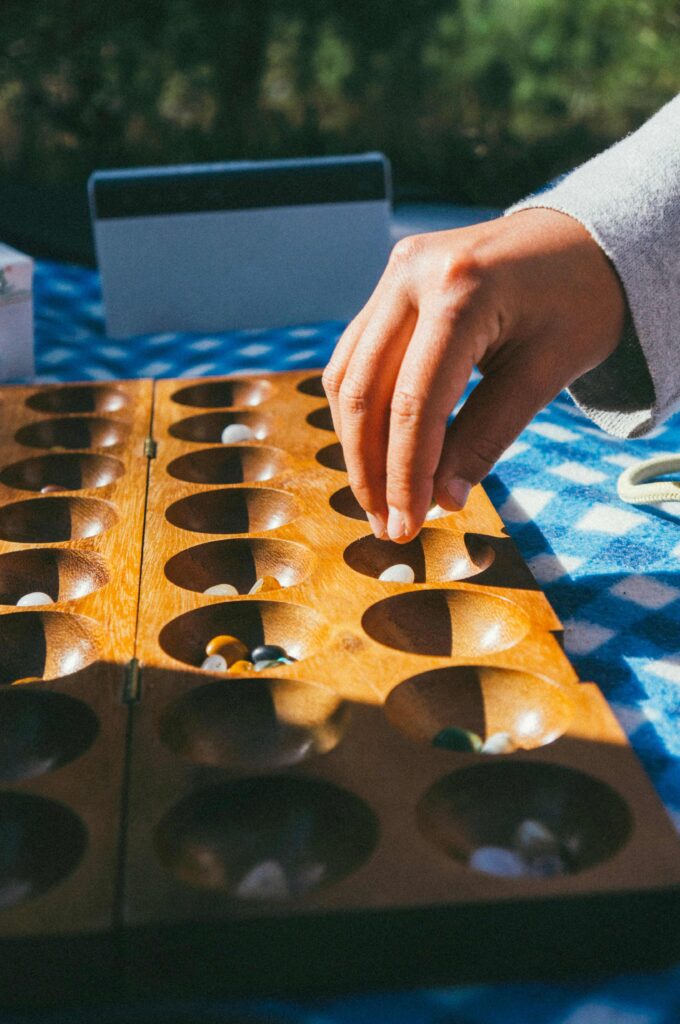
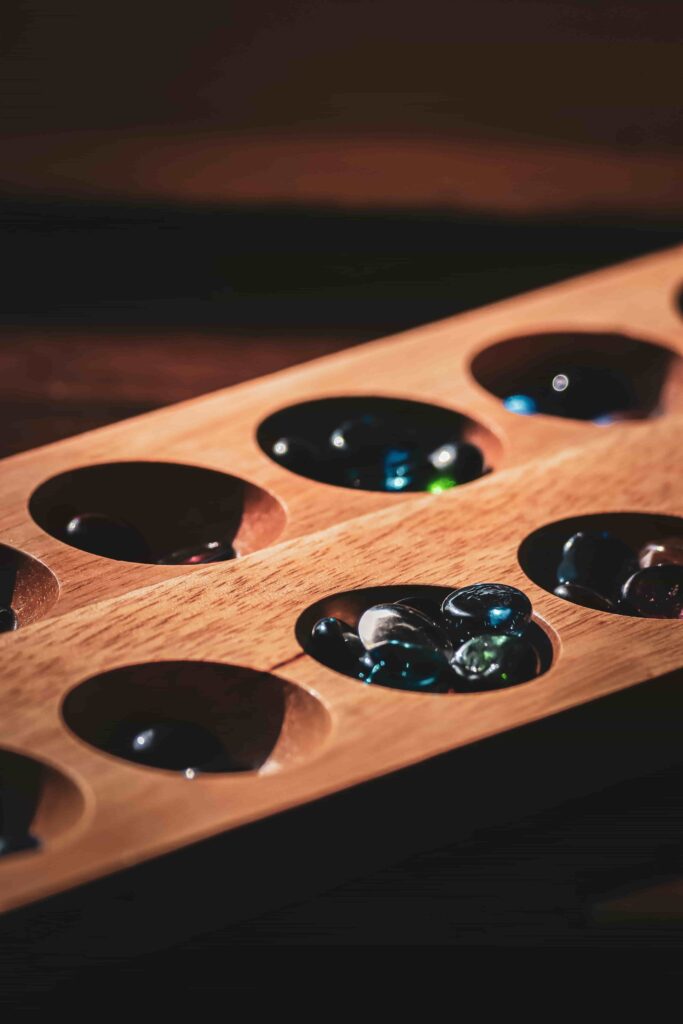
What are the most common mistakes players make in Mancala?
The most common mistakes players make in Mancala are:
Forgetting about your store:
New players often overlook the importance of their store. Remember, the goal is to capture the most pieces, not just move the most pieces. Take advantage of opportunities to sow pieces into your store and gain extra turns.
Overlooking forced moves:
You can take advantage of your opponent’s one lawful move by positioning the board so that it compels them to make a move that benefits you.
Ignoring your opponent’s strategy:
While focusing on your own game plan, don’t forget to keep an eye on your opponent’s strategy. You will have mastered Mancala if you can foil their schemes while advancing your own.
Making premature large moves that don’t secure stones:
Players should avoid making hasty large moves that don’t secure stones and missing opportunities to control crucial pits.
Losing count of stones:
It’s easy to lose count when there’s a large number of stones (7+) and your opponent is able to wrap all the way around your side of the board to execute a capture.
By avoiding these common mistakes and incorporating effective strategies like controlling the right pits, starving your opponent, and capturing stones strategically, you can improve your chances of winning at Mancala.
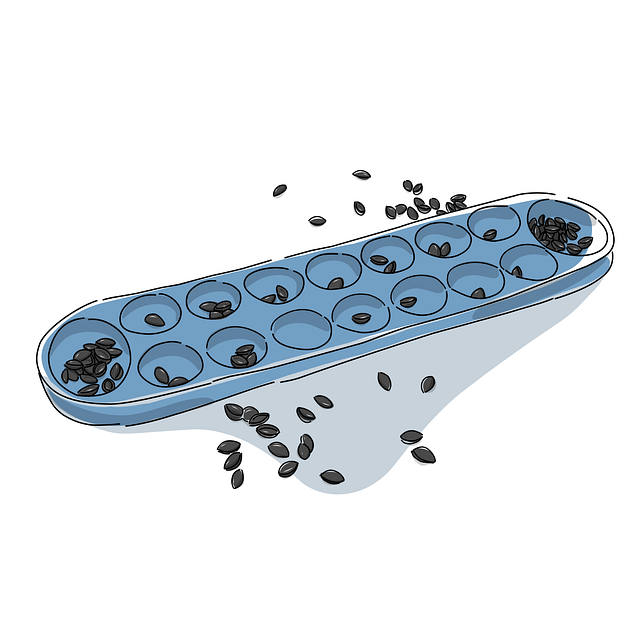
What are some strategies for forcing my opponent to make a specific move?
To force your opponent to make a specific move in Mancala, follow these strategies:
Use Checks:
Checks are the most forcing moves in Mancala. If you can check your opponent’s king, they are forced to move their king to avoid checkmate. This can lead to tactical opportunities and material gains.
Captures:
Capturing pieces can also be forcing. For example, if you capture a piece that your opponent cannot afford to lose, they will be forced to respond by recapturing. This can lead to further tactical opportunities.
Threats:
Threats to capture pieces or promote pawns can also be forcing. If your opponent cannot neutralize these threats, they will be forced to respond in a specific way, which can lead to tactical advantages.
Block Opponent’s Moves:
By blocking your opponent’s moves, you can force them to make a specific move to respond to your blockage. This can be particularly effective in controlling key pits and limiting your opponent’s options.
Control Key Pits:
Controlling key pits on the board can force your opponent to make specific moves to respond to your control. This can limit their options and create opportunities for you to gain an advantage.
Use the Rightmost Pit Strategically:
The rightmost pit on your side of the board can be used to force your opponent to make specific moves. By emptying this pit early, you can create opportunities for yourself and limit your opponent’s options.
Pay Attention to Forcing Moves:
Always look for forcing moves when calculating variations. These moves are the most likely to achieve something and are also the quickest to calculate, since the opponent can only make a limited number of responses.
Experiment with Forcing Moves:
Experimenting with forcing moves can help you create tactics and gain an advantage. By imagining the board after your forcing moves and seeing if changes create opportunities, you can develop your tactical skills.
By incorporating these strategies into your gameplay, you can increase your chances of forcing your opponent to make specific moves and gaining an advantage in Mancala.
Contact Us for any Question related to this Article.
Frequently Asked Questions
What is Mancala?
Mancala is a series of turn-based strategy board games for two players that are played on a board, other playing surface, or with small stones, beans, or seeds and rows of holes or pits in the ground. Usually, the goal is to take all of the opponent’s pieces, or a certain set of them.
How old is Mancala?
Mancala has a long history, with evidence of its existence dating back to ancient civilizations such as Ancient Egypt and the Middle East.
How do you set up a Mancala game?
To set up a Mancala game, place the game board between the two players lengthwise. Each player has six pockets directly in front of them and a mancala to their right. Place four stones or seeds in each of the 12 pockets, leaving the two mancalas empty.
What are the basic rules of Mancala?
The basic rules include:
- Players take turns moving stones from one of their pits to the right in a counter-clockwise direction.
- If the last stone lands in the player’s mancala, they get an extra turn.
- If the last stone lands in an empty pit on the player’s side, they capture all the stones in the opposite pit and place them in their mancala.
- When a single player drains every pit, the game is over. In a mancala, the player with the most stones wins.
How do you play Mancala?
To play Mancala, choose a starting pit and remove all the stones from it. Drop one stone in each pit, moving counter-clockwise around the board. If the last stone lands in your mancala, you get an extra turn. If it lands in an empty pit on your side, you capture the stones in the opposite pit.
How do you win at Mancala?
To win at Mancala, focus on getting a free turn by landing your last stone in your mancala, prevent your opponent from moving more than once, empty your rightmost pit early, capture stones from your opponent’s side, and manage the number of stones in each hole to starve your opponent.
What are some common mistakes players make in Mancala?
Common mistakes include forgetting about your store, overlooking forced moves, ignoring your opponent’s strategy, making premature large moves that don’t secure stones, and losing count of stones.
How do you force your opponent to make a specific move in Mancala?
To force your opponent’s moves, use checks, captures, threats, block their moves, control key pits, use the rightmost pit strategically, pay attention to forcing moves, and experiment with forcing moves. These FAQs cover the most important aspects of Mancala, including its history, setup, rules, gameplay, strategies, and common mistakes to avoid. By understanding these key points, players can improve their Mancala skills and enjoy the game more.
How do you decide who goes first in Mancala?
The player who goes first is usually determined by a random method such as flipping a coin or letting the youngest player go first.
What is the objective of Mancala?
The objective of Mancala is to capture more stones than your opponent by the end of the game.
How do you capture stones in Mancala?
You capture stones by moving them from one pit to the next, and if the last stone lands in an empty pit on your side, you capture all the stones in the opposite pit.
What is a “free turn” in Mancala?
A “free turn” is when you land your last stone in your mancala, allowing you to take another turn.
How do you manage your stones in Mancala?
Manage your stones by controlling the number of stones in each hole to starve your opponent and create opportunities for yourself.
What are some advanced strategies in Mancala?
Advanced strategies include using the rightmost pit strategically, controlling key pits, and experimenting with forcing moves.
What are some common mistakes to avoid in Mancala?
Common mistakes include forgetting about your store, overlooking forced moves, ignoring your opponent’s strategy, making premature large moves that don’t secure stones, and losing count of stones.
How do you avoid making these mistakes?
To avoid making these mistakes, focus on your store, pay attention to forced moves, consider your opponent’s strategy, make strategic moves, and keep track of the number of stones.
Where did Mancala originate?
Mancala has a long history, with evidence of its existence dating back to ancient civilizations such as Ancient Egypt and the Middle East.
Are there different variations of Mancala?
Yes, there are different variations of Mancala, each with its own unique rules and strategies.
How do you learn more about Mancala variations?
You can learn more about Mancala variations by researching online, reading books, or playing with different people.
What are some tips for improving at Mancala?
Tips for improving at Mancala include practicing regularly, focusing on your store, paying attention to forced moves, and experimenting with different strategies.
How do you improve your Mancala skills?
You can improve your Mancala skills by playing regularly, analyzing your games, and learning from your mistakes.
Are there any online resources for learning Mancala?
Yes, there are many online resources available for learning Mancala, including tutorials, videos, and online communities. These additional FAQs cover more aspects of Mancala, including game play and strategies, common mistakes, history and variations, and tips and tricks. By understanding these key points, players can improve their Mancala skills and enjoy the game more.
